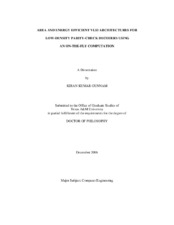| dc.contributor.advisor | Choi, Gwan S. | |
| dc.contributor.advisor | Miller, Scott | |
| dc.creator | Gunnam, Kiran Kumar | |
| dc.date.accessioned | 2010-01-14T23:59:46Z | |
| dc.date.accessioned | 2010-01-16T01:49:37Z | |
| dc.date.available | 2010-01-14T23:59:46Z | |
| dc.date.available | 2010-01-16T01:49:37Z | |
| dc.date.created | 2006-12 | |
| dc.date.issued | 2009-05-15 | |
| dc.identifier.uri | https://hdl.handle.net/1969.1/ETD-TAMU-1049 | |
| dc.description.abstract | The VLSI implementation complexity of a low density parity check (LDPC)
decoder is largely influenced by the interconnect and the storage requirements. This
dissertation presents the decoder architectures for regular and irregular LDPC codes that
provide substantial gains over existing academic and commercial implementations. Several
structured properties of LDPC codes and decoding algorithms are observed and are used to
construct hardware implementation with reduced processing complexity. The proposed
architectures utilize an on-the-fly computation paradigm which permits scheduling of the
computations in a way that the memory requirements and re-computations are reduced.
Using this paradigm, the run-time configurable and multi-rate VLSI architectures for the
rate compatible array LDPC codes and irregular block LDPC codes are designed. Rate
compatible array codes are considered for DSL applications. Irregular block LDPC codes
are proposed for IEEE 802.16e, IEEE 802.11n, and IEEE 802.20. When compared with a
recent implementation of an 802.11n LDPC decoder, the proposed decoder reduces the
logic complexity by 6.45x and memory complexity by 2x for a given data throughput.
When compared to the latest reported multi-rate decoders, this decoder design has an area efficiency of around 5.5x and energy efficiency of 2.6x for a given data throughput. The
numbers are normalized for a 180nm CMOS process.
Properly designed array codes have low error floors and meet the requirements of
magnetic channel and other applications which need several Gbps of data throughput. A
high throughput and fixed code architecture for array LDPC codes has been designed. No
modification to the code is performed as this can result in high error floors. This parallel
decoder architecture has no routing congestion and is scalable for longer block lengths.
When compared to the latest fixed code parallel decoders in the literature, this design has
an area efficiency of around 36x and an energy efficiency of 3x for a given data throughput.
Again, the numbers are normalized for a 180nm CMOS process. In summary, the design
and analysis details of the proposed architectures are described in this dissertation. The
results from the extensive simulation and VHDL verification on FPGA and ASIC design
platforms are also presented. | en |
| dc.format.medium | electronic | en |
| dc.format.mimetype | application/pdf | |
| dc.language.iso | en_US | |
| dc.subject | low-density parity-check (LDPC) codes | en |
| dc.subject | offset min-sum | en |
| dc.subject | parallel processing | en |
| dc.subject | vector processing | en |
| dc.subject | decoder architecture | en |
| dc.subject | layered decoding | en |
| dc.subject | turbo-decoding message passing | en |
| dc.subject | array LDPC | en |
| dc.subject | block LDPC | en |
| dc.subject | irregular LDPC | en |
| dc.subject | semi-parallel architecture | en |
| dc.title | Area and energy efficient VLSI architectures for low-density parity-check decoders using an on-the-fly computation | en |
| dc.type | Book | en |
| dc.type | Thesis | en |
| thesis.degree.department | Electrical and Computer Engineering | en |
| thesis.degree.discipline | Computer Engineering | en |
| thesis.degree.grantor | Texas A&M University | en |
| thesis.degree.name | Doctor of Philosophy | en |
| thesis.degree.level | Doctoral | en |
| dc.contributor.committeeMember | Hu, Jiang | |
| dc.contributor.committeeMember | Walker, Duncan M. | |
| dc.type.genre | Electronic Dissertation | en |
| dc.type.material | text | en |
| dc.format.digitalOrigin | born digital | en |


